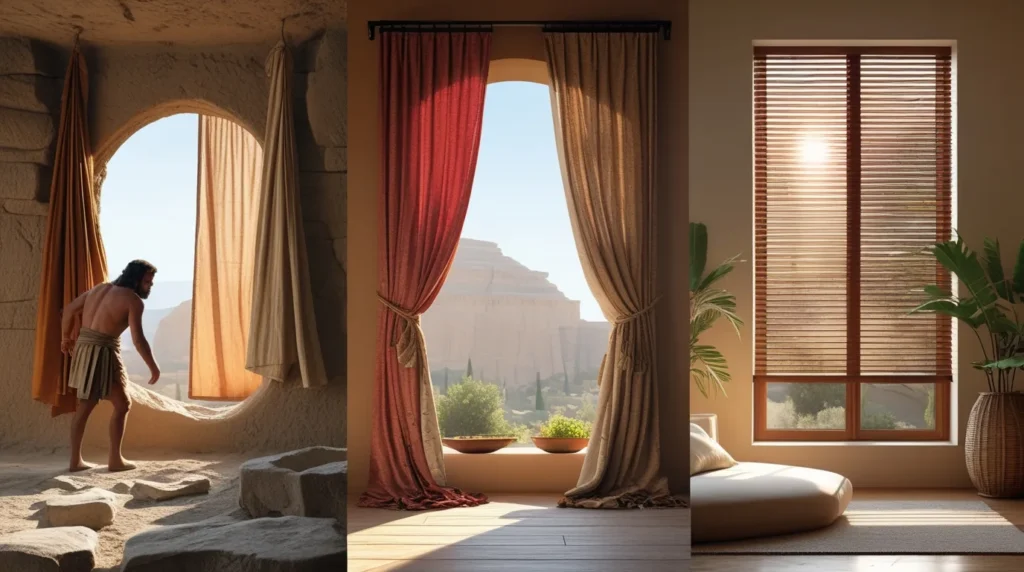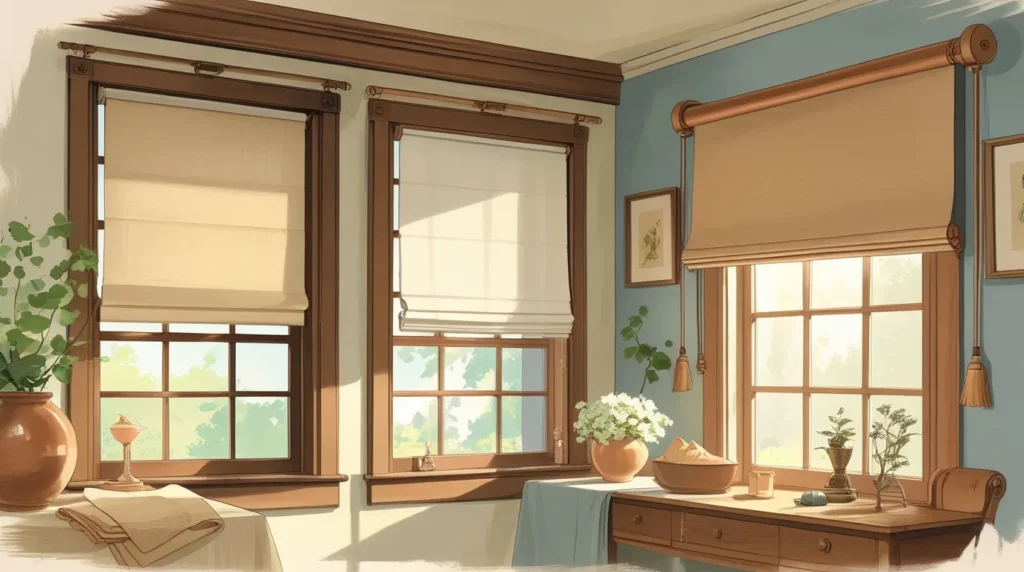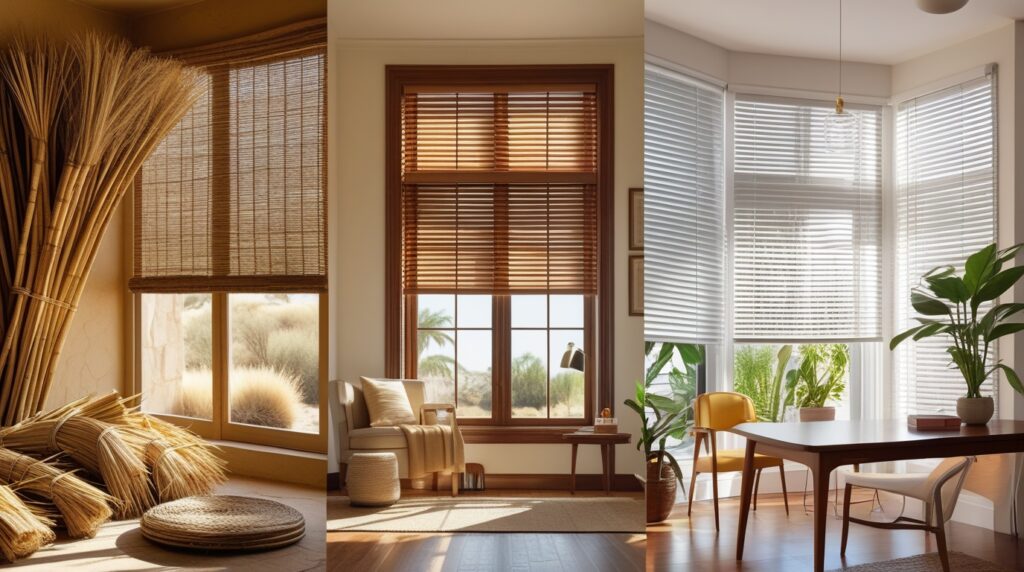Window Coverings Through the Ages: A Brief Look Back
Have you ever stopped to wonder, when were window blinds invented? Today, we see blinds in homes, schools, and offices. They’re everywhere. But once upon a time, people didn’t have glass windows, let alone blinds. Still, they found smart ways to block sunlight, wind, or curious eyes from outside.
Long ago, people used animal skins or pieces of cloth to cover wall openings. These early coverings gave privacy and warmth. Over time, as houses became more advanced, the need for better window coverings grew. Curtains came first, followed by more clever designs like shades and blinds.
Each step in this journey shows how humans kept solving small everyday problems in smart ways. Just like how we went from riding horses to driving cars, we moved from cloths over openings to the adjustable blinds we have today. This story isn’t just about windows—it’s about people, ideas, and making life more comfortable.
From Fabric Drapes to Slats: How We Started Covering Windows
In the early days of shelter, people needed ways to keep out dust, sun, or cold air. The easiest way? Hang a cloth. Fabric drapes were easy to make. People used wool, cotton, or animal hides. These were heavy and strong, and people would drape them over window holes.
Later, in places like ancient Rome and Egypt, fabric became fancier. Wealthy families used colored cloths that looked beautiful. Curtains became part of a home’s look, not just a tool.
Then came a new idea—what if we didn’t just cover the window, but controlled how much light came in? This thinking gave rise to window blinds. Instead of opening or closing a big curtain, you could tilt slats to let in just the right amount of sun. That small idea made a big difference in how homes felt.
Blinds also took up less space. You didn’t need long, heavy fabric hanging everywhere. Just a neat set of slats you could move with a string or rod. It was simple, clever, and made homes more flexible.
When Were Curtains Invented? Tracing the First Soft Window Coverings
Before window blinds took the spotlight, curtains were the go-to for covering windows. But when were curtains invented? The truth is, they go back thousands of years. Some of the first known curtains were used in Mesopotamia, one of the world’s oldest civilizations.
People would hang thick cloths over windows, doorways, and sleeping areas. In those days, homes didn’t have glass windows. Open spaces were left in walls for light and air. Curtains blocked dust during sandstorms and gave privacy when people needed to change or sleep.
As the years passed, fabric became easier to make. In ancient Rome, curtains were made of silk and linen. They were dyed in beautiful colors and often matched a room’s walls. In castles and large homes, curtains became symbols of wealth. The fancier the fabric, the richer the family.
Curtains weren’t just practical. They helped shape how we think about style and comfort in a room. Even today, many people still use curtains along with blinds or shades to soften the look of a space.
What Are Persian Blinds and Why Do They Matter in Blind History?
You’ve probably heard of vertical or horizontal blinds—but have you heard of Persian blinds? These were some of the earliest types of blinds ever made. Historians believe they came from ancient Persia, which is now part of modern-day Iran.
So, what were they like? Persian blinds had thin wooden slats tied together with cords. You could pull a string to lift or lower them. They were made from natural materials like bamboo or lightweight wood. Even back then, people wanted to control light and stay cool inside.
Persian blinds were so well designed that they spread to other parts of the world. Travelers and traders saw them and took the idea home. In Europe, builders copied the design and added their own touches. Later, this concept became what we know today as Venetian blinds.
It’s amazing to think that an idea from centuries ago still shapes what we use in our homes. Persian blinds were more than just window covers—they were proof that simple ideas can last for a very long time.
Who Invented Shades? The Overlooked Role of Early Innovators
While blinds use slats, shades are made of one solid piece of fabric. They go up and down using a pull cord or spring roller. But you may ask, who invented shades?
Unlike other inventions with a known creator, window shades have no clear inventor. They likely popped up in different parts of the world around the same time. In China, people made paper shades that rolled down over windows. In Europe, people used linen or cotton that was pulled over rods.
By the 1700s and 1800s, roller shades became common in homes. These used a wooden cylinder at the top and a cord at the bottom. Pulling the cord would roll the shade up or down. It was smooth, quiet, and easy to use.
What made shades special was their clean look. They didn’t have gaps like slats in blinds. This made them great for bedrooms or nurseries where people wanted full darkness. Today, shades come in many styles—some even block 100% of sunlight!
These early shade makers were problem solvers. They saw a need and used simple materials to fix it. That’s the spirit of invention in action.
When Were Window Blinds Invented? Exploring Their True Origins
Let’s return to the big question: when were window blinds invented? The earliest forms came from Persia, as we talked about earlier. But modern blinds—the kind with thin slats and a control cord—started appearing in the mid-1700s.
In France and Italy, wooden blinds were made for fancy homes. These blinds could be adjusted with strings. Instead of pulling back a heavy curtain, you could tilt the slats and let in just the right amount of light. People loved how neat and simple they looked.
By the 1800s, factories began making blinds in larger numbers. Businesses in Europe and America sold them to homes, shops, and schools. Aluminum blinds became popular in the early 1900s, especially in office buildings.
Today’s blinds have come a long way. You can find ones made from vinyl, metal, plastic, and even fabric. Some open with a remote. Others connect to your phone. But even the newest ones still follow that old idea—adjust the slats and control the light.
That original design from centuries ago is still going strong. It shows how a great idea doesn’t need to change too much to stay useful.
How Blinds Changed the Way We Use Windows in Our Homes
Before blinds, people just opened or closed a curtain. There was no in-between. You had either full sunlight or full darkness. But blinds changed everything.
With blinds, you can tilt the slats to let in just a little sunlight. You can still see outside but keep strangers from seeing in. You can adjust the mood of a room without turning on a light.
Blinds also helped people save energy. Blocking direct sunlight in the summer keeps rooms cooler. In the winter, closing blinds at night helps keep heat inside. These small changes made homes more comfortable and saved money too.
Designers love blinds because they’re clean and simple. You can match them to walls or make them stand out with bold colors. They can fit any window, big or small.
Without blinds, many of today’s buildings wouldn’t work the same way. Open-concept homes, glass walls, and sunrooms all rely on flexible window coverings to stay comfortable and private.
Materials Through Time: From Reed Mats to Modern Vinyl
The first window covers weren’t fancy. People used what they had—sticks, straw, reeds, or grass. They tied them together with thread and rolled them up. These reed mats worked well in hot places. They kept out the sun but let in air.
As tools improved, people started using wood. Thin slats could be cut, polished, and painted. Wood blinds looked rich and strong. But they were heavy and needed care.
In the 1900s, aluminum blinds became the new favorite. Light, strong, and easy to clean, they were perfect for offices and schools. Later, vinyl and plastic blinds came along. These were cheap to make, waterproof, and came in many colors.
Today, you can still buy wood blinds, but many people choose synthetic ones that look like wood. You get the beauty without the upkeep. Some blinds now have blackout layers, soundproofing, or UV protection.
All these materials show how far we’ve come—and how each step was about solving a real problem.
The Difference Between Blinds, Shades, and Curtains
It’s easy to mix them up, but blinds, shades, and curtains are not the same.
- Blinds are made of slats—wood, plastic, or metal—that you can tilt open or closed.
- Shades are a single piece of fabric that rolls or folds up and down.
- Curtains hang on a rod and are pulled to the side.
Each has its place. Curtains add softness and color. Shades are neat and quiet. Blinds offer the most control. Some people even use two or three types together!
Knowing the difference helps you pick what’s best for your room. If you want full darkness, try blackout shades. Want a mix of light and privacy? Blinds are a good choice.
Understanding these choices gives you control over how your home looks and feels.
Blinds Crafter’s View: Why Window History Still Matters Today in Saddle River, NJ
At Blinds Crafter, we believe that understanding the history of window coverings makes us better at what we do. In Saddle River, NJ, we help homeowners choose blinds that are both beautiful and practical—just like the ones that came before.
When we install blinds, we think about the materials, the light, and the feel of the room. We respect the history behind every design, whether it’s inspired by Persian blinds or modern innovations.
We also know every home is different. That’s why we offer custom solutions based on your space, style, and budget. With years of experience, we guide you through the process—from idea to installation—with care and skill.
Final Thoughts: What History Can Teach Us About Choosing the Right Window Coverings
Looking at the past helps us make smarter choices today. From reed mats and curtains to Persian blinds and motorized shades, people have always found ways to improve their homes.
The story of blinds isn’t just about materials or styles—it’s about solving problems with simple, clever ideas. That’s a story that still matters. The next time you open or close your blinds, think about the hands and minds behind that invention.
Blinds Crafter is here to help you make your space just right, with products that work and last. We’re proud to carry forward a long tradition of smart design and real comfort.
Ready to upgrade your window coverings? Contact Blinds Crafter today and let our team help you find the perfect fit for your home.




